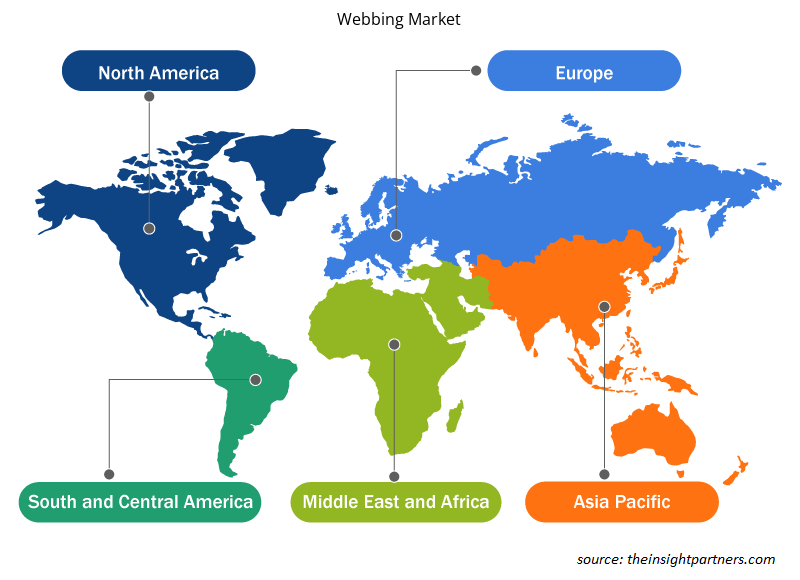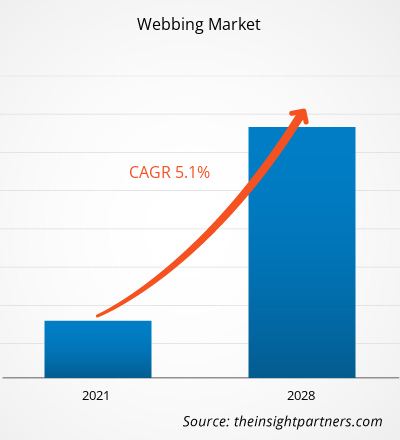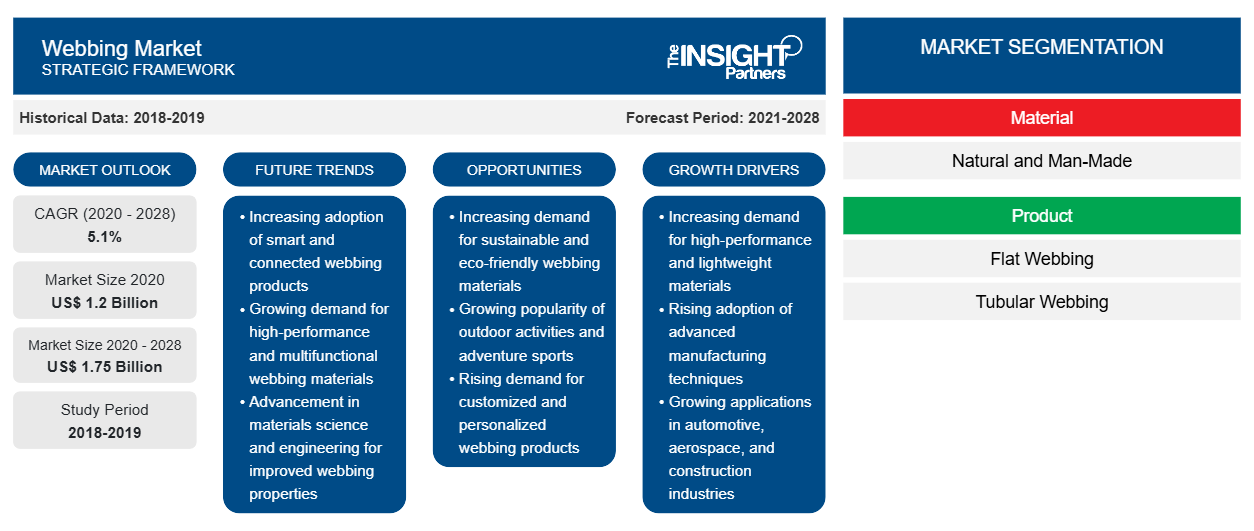Si prevede che il mercato delle cinghie raggiungerà i 1.745,84 milioni di dollari entro il 2028, rispetto ai 1.195,35 milioni di dollari del 2020; si prevede una crescita a un CAGR del 5,1% dal 2021 al 2028.
La fettuccia è una fibra intrecciata resistente disponibile in strisce piatte o in forma di tubo; è usata come sostituto della corda. Convenzionalmente, la fettuccia è prodotta utilizzando cotone e seta, tuttavia, polimeri, nylon e poliestere stanno sostituendo i materiali tradizionali. La fettuccia è nota per le sue proprietà come praticità, resistenza alla trazione e resistenza chimica; può essere usata come sostituto di fili di acciaio, corde o catene in varie applicazioni industriali. Le fettucce sono usate in modo significativo in abbigliamento militare, paracaduti, arrampicata, tessuti per autoveicoli, equipaggiamento antincendio, beni militari, imbracature, zaini, equipaggiamento da trekking e altro. Oltre a questo, la fettuccia è ampiamente usata per produrre equipaggiamento protettivo per i lavoratori del settore petrolifero e del gas.
Il segmento automobilistico deterrebbe la quota maggiore del mercato globale delle cinghie , per utilizzo finale, nel 2021. Le cinghie sono una componente significativa della produzione di cinture di sicurezza, imbracature di sicurezza, cinghie di trazione; legature dei bordi per capote; cinghie e legature per reti portabagagli; cinture di sicurezza per airbag; e così via. L'aumento della domanda di veicoli nelle economie in via di sviluppo come India e Cina sta supportando la crescita del mercato. Secondo il Global status report sulla sicurezza stradale, la crescente importanza e consapevolezza dell'uso della cintura di sicurezza per ridurre al minimo il rischio di decesso tra i passeggeri dei sedili anteriori e posteriori ha promosso la domanda di cinghie.
Nel 2021, l'Asia Pacifica rappresenterebbe la quota maggiore del mercato globale delle cinghie. Il predominio di questa regione nel mercato globale è attribuito principalmente alla presenza di un forte settore industriale, tra cui le unità produttive di diverse importanti aziende. La domanda di cinghie è elevata in settori verticali come automotive, aerospaziale e difesa, industriale e sicurezza, accessori moda, tessile e articoli sportivi. Inoltre, l'aumento degli investimenti nel settore manifatturiero offre opportunità redditizie per la crescita del mercato delle cinghie nell'Asia Pacifica. Si prevede che le politiche favorevoli implementate dal governo indiano come Atmanirbhar Bharat e Make in India creeranno sufficienti opportunità di crescita per le diverse basi industriali, il che, a sua volta, aumenterebbe il consumo di cinghie nella regione.
Personalizza questo report in base alle tue esigenze
Riceverai la personalizzazione gratuita di qualsiasi report, comprese parti di questo report, o analisi a livello nazionale, pacchetto dati Excel, oltre a usufruire di grandi offerte e sconti per start-up e università
-
Scopri le principali tendenze di mercato in questo rapporto.Questo campione GRATUITO includerà analisi di dati che spaziano dalle tendenze di mercato alle stime e alle previsioni.
Impatto della pandemia di COVID-19 sul mercato delle cinghie
A giugno 2021, Stati Uniti, India, Brasile, Russia, Regno Unito, Francia, Spagna, Italia, Turchia, Germania, Colombia e Argentina sono tra i paesi più colpiti dalla pandemia di COVID-19. Le misure imposte per contenere la diffusione della malattia, tra cui lockdown, divieti di viaggio e chiusure aziendali, hanno avuto un impatto grave sulle economie e sulle industrie di diversi paesi. I prodotti chimici e i materiali sono uno dei settori chiave che sta subendo gravi interruzioni a causa dell'interruzione delle catene di fornitura e delle operazioni degli impianti. La chiusura degli impianti di produzione in regioni come Nord America, Europa e APAC ha ostacolato le catene di fornitura globali, influenzando così i processi di produzione, i programmi di distribuzione e le vendite dei prodotti. Le conseguenze della pandemia di COVID-19 hanno anche portato al rallentamento della produzione, della domanda e del commercio di cinghie. La chiusura dei confini nazionali e internazionali ha influenzato le strategie di sviluppo aziendale di varie aziende. Tuttavia, con le economie che pianificano di rilanciare le proprie operazioni, allentare le misure di blocco e condurre campagne di vaccinazione di massa, è probabile che il mercato delle cinghie si riprenda nei prossimi mesi.
Approfondimenti di mercato
L'aumento della domanda di cinghie sintetiche contribuisce in modo significativo alla crescita del mercato delle cinghie
La domanda di fettucce artificiali è aumentata in modo significativo, più significativamente rispetto ai materiali naturali per fettucce. Fibre aramidiche, polibenzoxazolo, poliestere, polipropilene e nylon sono i vari tipi di materiali sintetici artificiali utilizzati nelle fettucce. Il poliestere è noto per le sue varie caratteristiche eccezionali, come elevata resistenza alla trazione e resistenza all'acqua, all'abrasione e al deterioramento ultravioletto, facile manutenzione insieme a resistenza all'acqua, alle abrasioni e alle radiazioni ultraviolette, allungamento e restringimento, resistenza e resistenza chimica. Pertanto, tra gli altri tipi di materiale per fettucce artificiali, l'uso di fettucce a base di poliestere è stato esteso a una gamma diversificata di basi di applicazione, come applicazioni di tessuti marini, maniglie per borse, legacci per vele e cinghie di supporto. Inoltre, le imbracature realizzate in poliestere sintetico (materiale in fibra) sono relativamente più leggere sia delle imbracature in fune metallica che delle imbracature a catena. Oltre al poliestere, la domanda di nylon è elevata a causa della sua migliore elasticità rispetto ad altri materiali. Le fettucce a base di nylon vengono utilizzate. Tale proprietà ne ha consentito l'uso in numerose applicazioni finali come airbag, cinture di sicurezza, imbracature di sicurezza e reti portabagagli, tra le altre. Inoltre, le caratteristiche notevoli delle fibre di carbonio hanno diverse caratteristiche come l'espansione termica limitata, abbinata alla tolleranza verso condizioni di tolleranza di temperatura estreme, resistenza chimica, elevata resistenza alla trazione e leggerezza, nonché elevata resistenza alla trazione, che le rendono un materiale ideale per le fettucce. Le fettucce a base di fibra di carbonio vengono utilizzate per essere utilizzate in articoli militari e sportivi.
Approfondimenti sui materiali
Sulla base del materiale, il mercato delle cinghie è suddiviso in naturale e artificiale. Il segmento artificiale sta attualmente dominando il mercato, in termini di quota di fatturato. La crescita del mercato di questo segmento è attribuita a prezzi più bassi e a una migliore disponibilità di materiali artificiali utilizzati nella produzione di cinghie. Questi materiali includono poliestere, nylon, polipropilene, fibre aramidiche, polibenzoxazolo, filato polimerico a cristalli liquidi e polietilene ad alto modulo. Le cinghie in poliestere sono comunemente utilizzate in applicazioni che richiedono capacità di carico da basse ad alte. Grazie alla sua superiore resistenza allo sbiadimento, le cinghie in poliestere sono sempre più utilizzate in applicazioni di tessuti marittimi come cinghie di supporto, legacci per vele e maniglie per borse. Inoltre, il poliestere è noto per le sue proprietà superiori come asciugatura rapida, facile pulizia ed elevata resistenza alla trazione, nonché resistenza al deterioramento da raggi ultravioletti, acqua, abrasioni, allungamento, restringimento, esposizione chimica e crescita di muffe.
Approfondimenti sui prodotti
In base al prodotto, il mercato delle fettucce è suddiviso in fettucce piatte, fettucce tubolari e altri prodotti. Il segmento delle fettucce piatte sta attualmente dominando il mercato, in termini di quota di fatturato. Le fettucce piatte, spesso note come funi piatte, sono realizzate in fibre intrecciate in modo solido e sono disponibili in vari spessori e larghezze. Le fettucce piatte funzionano efficacemente in applicazioni in cui il materiale può essere intrecciato in un prodotto più grande, come cinghie per zaini, cinture di sicurezza e legature di rinforzo. Di solito sono più rigide dei tessuti tubolari.
Approfondimenti sull'uso finale
In base all'uso finale, il mercato delle cinghie è segmentato in aerospaziale, automobilistico, militare, industriale e di sicurezza, accessori di moda, e-textile, articoli sportivi, nautico, medico e altri. Il segmento aerospaziale sta attualmente dominando il mercato, in termini di quota di fatturato. Lo sviluppo e l'uso delle cinghie hanno rivoluzionato l'industria aerospaziale. Le caratteristiche delle cinghie intrecciate come alte prestazioni e peso ridotto aiutano a soddisfare rigorosi standard di settore applicabili all'industria aerospaziale. Le cinghie intrecciate conferiscono anche vantaggi come calore, marciume chimico e resistenza all'abrasione e facile pulizia alle applicazioni aerospaziali. Inoltre, i tessuti stretti specializzati, i tessuti termoindurenti 2D e 3D, i tessuti termoplastici e le nuove cinghie elettroniche sono adatti per soddisfare specifici requisiti di resistenza del settore. Inoltre, i materiali sono ampiamente utilizzati in applicazioni aerospaziali cruciali come paracaduti, sistemi di contenimento del carico e sedili, nonché in alcune applicazioni interne come componenti del sistema di sicurezza dell'equipaggio, tute da volo, scivoli d'aria, cinture di sicurezza e dispositivi di galleggiamento.
Alcuni dei principali attori chiave che operano nel mercato delle cinghie sono American Cord & Webbing Co, Inc.; Belt-tech; E. Oppermann GmbH; Narrowtex Australia; e National Webbing Products Co. Questi attori del mercato si stanno concentrando molto sullo sviluppo di offerte di prodotti innovativi e di alta qualità.
Segnala i riflettori
- Tendenze del settore delle reti progressive per aiutare i giocatori a sviluppare strategie efficaci a lungo termine
- Strategie di crescita aziendale adottate dagli operatori del mercato del web nei mercati sviluppati e in via di sviluppo
- Analisi quantitativa del mercato dal 2019 al 2028
- Stima della domanda globale di cinghie
- Analisi PEST per illustrare l'efficacia degli acquirenti e dei fornitori che operano nel settore
- Sviluppi recenti per comprendere lo scenario competitivo del mercato
- Tendenze e prospettive del mercato, nonché fattori che guidano e frenano la crescita del mercato delle cinghie
- Assistenza nel processo decisionale evidenziando le strategie di mercato che sostengono l'interesse commerciale, portando alla crescita del mercato
- Panoramica dettagliata e segmentazione del mercato, nonché dinamiche del settore delle cinghie
- Dimensioni del mercato delle cinghie in varie regioni con promettenti opportunità di crescita
Approfondimenti regionali sul mercato delle cinghie
Le tendenze regionali e i fattori che influenzano il Webbing Market durante il periodo di previsione sono stati ampiamente spiegati dagli analisti di Insight Partners. Questa sezione discute anche i segmenti e la geografia del Webbing Market in Nord America, Europa, Asia Pacifico, Medio Oriente e Africa, e Sud e Centro America.

- Ottieni i dati specifici regionali per il mercato delle cinghie
Ambito del rapporto sul mercato delle cinghie
| Attributo del report | Dettagli |
|---|---|
| Dimensioni del mercato nel 2020 | 1,2 miliardi di dollari USA |
| Dimensioni del mercato entro il 2028 | 1,75 miliardi di dollari USA |
| CAGR globale (2020 - 2028) | 5,1% |
| Dati storici | 2018-2019 |
| Periodo di previsione | 2021-2028 |
| Segmenti coperti |
Per materiale
|
| Regioni e Paesi coperti |
America del Nord
|
| Leader di mercato e profili aziendali chiave |
|
Densità degli attori del mercato del webbing: comprendere il suo impatto sulle dinamiche aziendali
Il mercato del Webbing Market sta crescendo rapidamente, spinto dalla crescente domanda degli utenti finali dovuta a fattori quali l'evoluzione delle preferenze dei consumatori, i progressi tecnologici e una maggiore consapevolezza dei vantaggi del prodotto. Con l'aumento della domanda, le aziende stanno ampliando le loro offerte, innovando per soddisfare le esigenze dei consumatori e capitalizzando sulle tendenze emergenti, il che alimenta ulteriormente la crescita del mercato.
La densità degli operatori di mercato si riferisce alla distribuzione di aziende o società che operano in un particolare mercato o settore. Indica quanti concorrenti (operatori di mercato) sono presenti in un dato spazio di mercato in relazione alle sue dimensioni o al valore di mercato totale.
Le principali aziende che operano nel mercato delle cinghie sono:
- AMERICAN CORD & WEBBING CO., INC.
- MULINI A NASTRO BALLY
- TECNOLOGIA DELLA CINTURA
- E. OPPERMANN GMBH
- MURDOCK WEBBING COMPANY, INC.
Disclaimer : le aziende elencate sopra non sono classificate secondo un ordine particolare.

- Ottieni una panoramica dei principali attori del mercato delle fettucce
Mercato delle cinghie, per materiale
- Naturale
- Fatto dall'uomo
Mercato delle cinghie, per prodotto
- Cinghia piatta
- Cinghie tubolari
- Altri
Mercato delle cinghie, per prodotto
- Aerospaziale
- Automobilistico
- Militare
- Industriale e sicurezza
- Accessori di moda
- E-Tessuto
- Articoli sportivi
- Marino
- Medico
- Altri
Profili aziendali
- Azienda produttrice di corde e nastri adesivi American Cord & Webbing Co., Inc.
- Mulini a nastro Bally
- Cintura-tecnologia
- E. Oppermann GmbH
- Azienda produttrice di tessuti Murdock Webbing, Inc.
- Strettotex Australia
- Azienda nazionale di prodotti tessili
- Azienda produttrice di nastri trasportatori in plastica dell'Ohio.
- Corporazione di nastri
- Prodotti per cinghie del Tennessee
- Analisi storica (2 anni), anno base, previsione (7 anni) con CAGR
- Analisi PEST e SWOT
- Valore/volume delle dimensioni del mercato - Globale, Regionale, Nazionale
- Industria e panorama competitivo
- Set di dati Excel
Report recenti
Testimonianze
Motivo dell'acquisto
- Processo decisionale informato
- Comprensione delle dinamiche di mercato
- Analisi competitiva
- Analisi dei clienti
- Previsioni di mercato
- Mitigazione del rischio
- Pianificazione strategica
- Giustificazione degli investimenti
- Identificazione dei mercati emergenti
- Miglioramento delle strategie di marketing
- Aumento dell'efficienza operativa
- Allineamento alle tendenze normative























 Ottieni un campione gratuito per - Mercato delle cinghie
Ottieni un campione gratuito per - Mercato delle cinghie